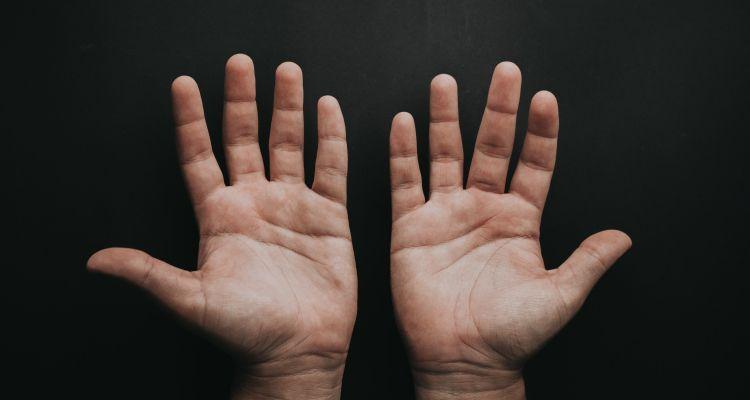
Seborrhoeic Eczema - Symptoms, Causes & Treatment
Updated on 02. November 2023
Redness and scaly skin on the head or face are the first indications of seborrhoeic eczema. This skin disease, also called seborrhoeic dermatitis, is generally harmless. Especially when visible areas on the face are affected, seborrhoeic dermatitis can also affect self-esteem. This article is intended to help sufferers learn more about seborrhoeic eczema and treatment options.
Seborrhoeic eczema Brief overview:
- Causes: Concrete cause not yet precisely investigated
- Symptoms: Yellowish dandruff on the face or under the hair
- Prevention: Avoid stress
- Treatment: Depends on shape & severity
What are the symptoms of seborrhoeic eczema?
In seborrhoeic eczema, yellowish scales usually appear on the face or under the hair. The dandruff is noticeably greasy and mainly occurs as coherent inflammatory foci. The skin underneath is red and irritated. If the scalp is affected, itching may also occur in some cases. Likewise, if seborrhoeic eczema occurs frequently on the scalp, hair loss may occur. The symptoms occur in irregular episodes.
When does itching occur with seborrhoeic eczema?
Seborrhoeic eczema is usually not itchy. An exception is a chronic course on the scalp. In this case, severe itching may develop. Scratching should be avoided at all costs, otherwise there is a high risk of secondary infection.
On which parts of the body does seborrhoeic eczema occur?
Seborrhoeic eczema most commonly occurs on areas of the body that have a higher concentration of sebaceous glands. These include:
- Scalp
- Between and on the eyebrows
- Around the nose and on the cheeks
- On and behind the ears
- Rarely sternum and the back in the thoracic spine area
- Rarely skin folds under the breast, in the armpit area or in the groin area
- In men in the beard area
- In men in the genital area
What are the different forms of seborrhoeic eczema?
Seborrhoeic eczema can occur in varying degrees and severity. Therefore, the disease is divided into three different forms:
- Seborrhoeic eczematid: preliminary stage of dermatitis with local scales and redness, heavy sweat production and sebum secretion.
- Focal seborrhoeic eczema: moderate to severe course, inflammatory foci are reddened, irregular and yellowish scaling, chronic course
- Disseminated seborrhoeic eczema: moderate to severe course, extensive, scaly and inflammatory red foci, sometimes weeping and crusting skin defects.
Can I confuse seborrhoeic eczema with other skin conditions?
The symptoms of seborrhoeic eczema are similar to those of other skin diseases. Psoriasis, also called psoriasis, shows similar symptoms. They can be distinguished by the spread of the skin changes. In both skin diseases, the redness and scaling cross the border between the forehead and the hairline. In psoriasis, the affected area is sharply defined. In seborrhoeic eczema, on the other hand, there are pockets of inflammation that are not clearly demarcated. Another clue is hair loss, which only occurs in seborrhoeic dermatitis. An exact diagnosis can be made by a doctor.
How do I recognise seborrhoeic eczema in babies?
A special form is seborrhoeic eczema in babies, colloquially called gneiss. This skin disease is characterised by sharply defined, reddened areas. The affected areas are covered with yellowish scales, but hardly cause itching. The disease usually begins between the 2nd and 4th week of life on the scalp with the so-called "cradle cap". Depending on the severity, the forehead, neck and the nappy area with the groin can also be affected in the further course.
What is the cause of seborrhoeic eczema?
The specific cause of the disease has not yet been researched. It is assumed that seborrhoeic eczema is caused by several factors. An increased sebum production is assumed to be an important factor. Another factor could be the usually harmless colonisation of the skin with a yeast fungus, Malassezia furfur.
What are the risk factors for seborrhoeic eczema?
Seborrhoeic eczema can occur in people of all ages and sexes. The majority of people affected are male. There are some factors that can increase the risk. These include:
- Age: Seborrhoeic eczema is more common in people aged 30 to 60 years.
- Genetics: A family history of the condition increases the risk of getting it.
- Hormones: Hormonal changes could make seborrhoeic eczema worse. Babies and women during pregnancy or menopause are more likely to get the disease.
- Diseases: People with neurological diseases like Parkinson's or HIV are at higher risk for seborrhoeic eczema.
- Stress: Seborrhoeic eczema can be triggered or made worse by stress.
- Skin condition: People with oily skin and hair are also more susceptible to seborrhoeic eczema.
- Weather: Most sufferers experience fewer symptoms in the summer months.
How is seborrhoeic eczema treated?
Treatment of the skin condition depends on the form and severity of the symptoms. So far, there is no treatment that completely cures seborrhoeic eczema. Seborrhoeic eczema is a harmless condition that is not contagious. The symptoms such as scaling and redness can be treated well.
What remedies help against seborrhoeic eczema?
Various active substances are used for the treatment. The aim is to reduce the fungal infestation. Effective drugs include:
- Antifungals: Applied externally, these antifungals fight the spread of the yeast fungus. This group includes: Selenium sulphide, zinc pyrithione and for more severe symptoms, ketoconazole and miconazole.
- Keratolytics: These agents slough off the dead skin cells that can clog the pores. Agents such as salicylic acid thereby reduce the effects of seborrhoeic eczema.
- Calcineurin inhibitors: These inhibit the immune system and have an anti-inflammatory effect. The active ingredient pimecrolimus in particular has shown initial success in the treatment of seborrhoeic eczema. The active ingredient tacrolimus, which is also said to have a fungicidal effect on the skin fungus Malassezia furfur, also belongs to this group.
- Glucocorticoid: In cases of severe redness or weeping, cortisone is used before treatment with antimycotics. It curbs the inflammation and has a decongestant effect.
The active substances are contained in externally applied creams and ointments. These help with seborrhoeic eczema on the nose, ears and body. Special shampoos are used for the scalp.
Which shampoo helps against seborrhoeic eczema?
If symptoms occur on hairy areas such as the scalp, beard or chest, a special shampoo against seborrhoeic eczema is necessary. Many patients choose the test winner of anti-dandruff products as shampoo. These products are usually not suitable because they are more effective against dry scalp. Choosing the wrong seborrhoeic eczema remedy can make the symptoms worse. Instead, the use of products with antimycotics, such as selenium sulphide or ketoconazole, is advisable. To protect the eyes, it is better to use a cream or ointment for seborrhoeic eczema on the eyebrows.
When should I see a doctor for seborrhoeic eczema?
A dermatologist can make an accurate diagnosis and advise on treatment options. Some medications or treatments for skin fungus can have undesirable side effects. Especially in the case of allergies, the choice of the right medication can only be made by a doctor. In addition, the dermatologist can perform regular monitoring of the skin and symptoms to prevent recurrences.
What measures support seborrhoeic eczema?
In addition to medication, lifestyle changes can alleviate symptoms. Diet plays an important role in seborrhoeic eczema. Avoiding sugar, carbohydrates and animal fats can reduce sebum production. Stress reduction through relaxation techniques such as yoga can also have a positive effect on the skin's appearance. In severe cases, light therapy that delivers ultraviolet light to the affected skin structure can help alleviate the symptoms.
How is seborrhoeic eczema treated in babies?
Seborrhoeic dermatitis in infants usually does not need to be treated. The disease does not affect the children. Within the first year of life, headgear subsides on its own. Thick dandruff on the scalp can be softened by rubbing it with oil or greasy cream. After two hours, they can be easily rubbed off in a bath. If other areas of the skin are affected, regular bathing with a little added oil usually helps. The baby's skin is cared for with moisturising creams. Affected skin folds are cared for with zinc ointment so that no open spots develop. If the zinc ointment is not enough, a doctor should be consulted.
When should I take my baby to the doctor for seborrhoeic eczema?
If seborrhoeic eczema is suspected, a visit to the doctor may be advisable. This is especially true if the diagnosis is uncertain or the symptoms worsen despite care. Often, the suspicion can be clarified during a routine check-up. If there is also severe itching or weeping from the third month of life onwards, it is imperative that the infant is seen by a doctor. This can be an indication of complications that should be treated quickly.
What home remedies help with seborrhoeic eczema?
There are several home remedies that can help relieve symptoms of seborrhoeic eczema. However, it is important to note that some home remedies do not show the same effectiveness in every patient. For those with allergies, a test with a soaked cotton ball on an area of skin that is not visible is useful. Some home remedies that may be helpful in treating seborrhoeic eczema are:
- Tea tree oil: Tea tree oil contains substances that work against fungal infections. As a result, it can help reduce dandruff and redness on the scalp. To use, add a few drops to shampoo or hair care products and mix well.
- [Witch hazel](): The tannins in witch hazel react with the proteins in the skin. This forms a thin protective film on the skin. Thanks to this astringent property, witch hazel is effective against itching and inhibits inflammation in seborrhoeic eczema. Regular treatment with witch hazel for seborrhoeic eczema calms the skin and the redness subsides more quickly.
- Coconut oil: Coconut oil has antimicrobial and anti-inflammatory properties and can help soothe the skin. The oil is applied to the affected areas or used as a hair mask.
- Apple cider vinegar: Apple cider vinegar helps to balance the pH of the skin in seborrhoeic eczema. This makes it harder for fungi and bacteria to spread on the skin. Diluted with water, the vinegar is applied with a cotton pad.
If the symptoms worsen or additional discomfort occurs, the products should be discontinued immediately.

Hameli's vision
Go to Vision
Vaginal Fungus - Symptoms, Causes & Treatment
Go to Vaginal mycosis
Dry skin - What helps against it?
Go to Dry skin
Witch hazel - varieties, cutting, effect, & products
Go to Witch Hazel
Recognise and treat coccygeal fistula
Go to Coccygeal fistula
Anal fistula - symptoms, causes & treatment
Go to Anal fistula
Labial tear - Symptoms, Causes & Treatment
Go to Labial tear
Intertrigo - Cause, symptoms and treatment of the skin wolf
Go to Intertrigo
Anal abscess: symptoms, recognition, causes & treatment
Go to Anal abscess
Chickenpox - symptoms, vaccination, infection and treatment | Hamelis
Go to Chickenpox
Anal fissure - Symptoms. Causes & home remedies
Go to Anal fissure
Vaginal dryness - symptoms, causes & treatment
Go to Vaginal dryness
Hives - Cause, symptoms and treatment
Go to Hives
Hamelis experts
Go to Experts
Rose lichen - symptoms, causes and treatment
Go to Rose lichen
Scars - treatment and removal
Go to Scar
Ringworm: Symptoms, Causes & Treatment
Go to Ringworm
Scabies - symptoms, cause and treatment
Go to Scabies
Treat anal eczema sustainably
Go to Anal eczema
Eczema - symptoms, causes and treatment
Go to Eczema
Contact allergy - symptoms and treatment
Go to Contact allergy
Treat stubborn nail fungus
Go to Nail fungus
Crabs - Intimate area, symptoms & treatment
Go to Crabs
Pruritus - Causes, symptoms and treatment
Go to Pruritus
Rosacea on the face - symptoms, causes and treatment
Go to Rosacea
Perioral dermatitis - symptoms, treatment & home remedies
Go to Perioral dermatitis
Skin fungus - cause, symptoms and treatment
Go to Skin fungus
Perineal tear - origin, degrees & causes
Go to Perineal laceration
Anal prolapse: symptoms, causes, treatment
Go to Anal prolapse
Skin rash - causes and treatment
Go to Skin rash
Genital herpes - woman, man & symptoms
Go to Genital herpes
Atopic dermatitis in children, adults and pets
Go to Atopic dermatitis
Angioedema - symptoms, causes and therapy
Go to Angioedema
Nappy dermatitis - cause and treatment of sore baby bottom
Go to Diaper rash
Sunburn - symptoms, duration & what helps?
Go to Sunburn
